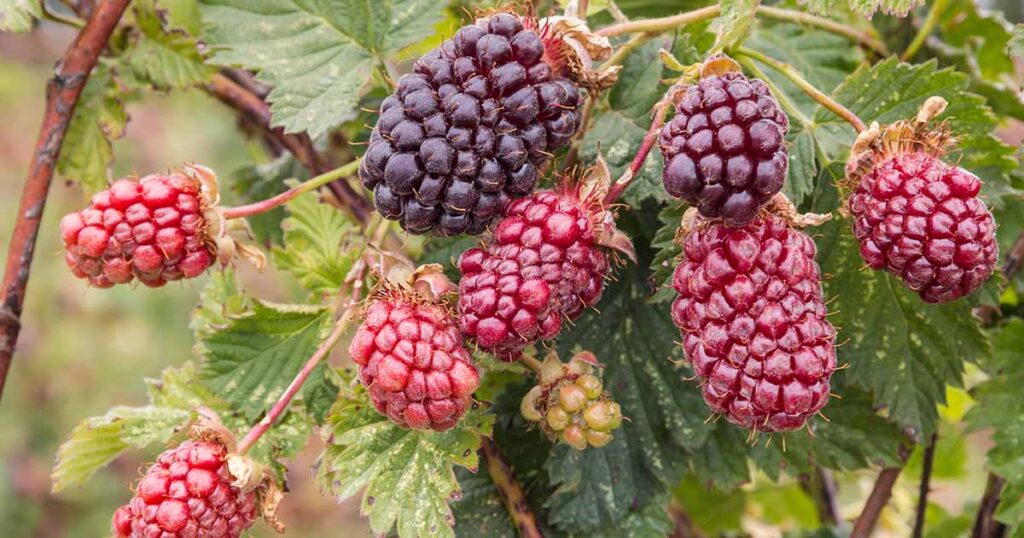Boysenberries are a delightful and nutritious fruit, prized for their sweet-tart flavour and versatility in the kitchen. A hybrid of raspberries, blackberries, loganberries, and dewberries, boysenberries require proper care to thrive. One effective method to enhance their growth, yield, and pest resistance is through companion plants of boysenberries. Companion planting is the practice of strategically growing plants together to maximize their mutual benefits. When selecting companion plants for boysenberries, consider factors such as pest control, soil enrichment, space efficiency, and overall plant health.
Benefits of Companion Planting for Boysenberries
Companion planting offers numerous benefits for boysenberries:
- Pest Control: Some plants naturally deter pests that would otherwise harm boysenberries.
- Soil Enrichment: Certain companion plants improve soil quality by fixing nitrogen or adding essential nutrients.
- Pollinator Attraction: Flowers and herbs can attract bees and butterflies, boosting pollination and fruit production.
- Weed Suppression: Some plants act as natural ground cover, reducing weed competition.
- Enhanced Growth: Certain plants may encourage stronger growth by improving the microclimate or enhancing soil moisture retention.
Best Companion Plants for Boysenberries
1. Marigolds (Tagetes spp.)
Marigolds are known for repelling nematodes, aphids, and other harmful insects. They also attract beneficial pollinators, making them an excellent companion for boysenberries. Their bright colours add aesthetic appeal to the garden while serving a practical purpose.
2. Garlic (Allium sativum) and Onions (Allium cepa)
Garlic and onions are natural pest repellents. Their strong odour deters aphids, spider mites, and other pests that could damage boysenberry companions plants. Additionally, these plants are low-maintenance and can be grown in the same garden bed as boysenberries.
3. Chives (Allium schoenoprasum)
Chives share many benefits with garlic and onions. They repel aphids and enhance soil health while also providing an edible herb for culinary use.
4. Nasturtiums (Tropaeolum majus)
Nasturtiums are excellent trap crops, meaning they attract aphids away from boysenberries. They also produce vibrant flowers that attract pollinators, leading to increased fruit production.
5. Clover (Trifolium spp.)
Clover is a nitrogen-fixing plant, which means it helps enrich the soil by converting atmospheric nitrogen into a form that boysenberries can use. This leads to healthier plants and improved berry production.
6. Borage (Borago officinalis)
Borage is an excellent companion for boysenberries because it attracts bees and other pollinators. It also improves soil quality by adding trace minerals and repelling certain pests like tomato hornworms.
7. Chamomile (Matricaria chamomilla)
Chamomile enhances the flavour of nearby fruits and has antifungal properties that help protect boysenberries from diseases. It also attracts beneficial insects such as ladybugs and hoverflies.
8. Mint (Mentha spp.)
Mint repels pests like ants and aphids while attracting pollinators. However, mint spreads aggressively, so it’s best planted in containers to prevent it from overtaking your boysenberry patch.
9. Comfrey (Symphytum spp.)
Comfrey is a deep-rooted plant that helps improve soil structure by bringing up nutrients from deep underground. It can be used as a mulch or compost ingredient to nourish boysenberries.
10. Strawberries (Fragaria spp.)
Strawberries and boysenberries can be planted together as they have similar growing requirements. Strawberries’ low growth rate provides ground cover, helping retain soil moisture and suppressing weeds.
11. Bee Balm (Monarda spp.)
Bee balm is another great pollinator attractant. It encourages bees and butterflies to visit the garden, improving fruit set in boysenberries.
12. Yarrow (Achillea millefolium)
Yarrow attracts beneficial insects like ladybugs, lacewings, and parasitic wasps, which help control aphid populations. It also adds nutrients to the soil.
13. Thyme (Thymus vulgaris)
Thyme is a great ground cover that helps retain soil moisture. It also repels pests like cabbage worms and attracts pollinators.
Plants to Avoid Near Boysenberries
Not all plants make good neighbours for boysenberries. Some plants may compete for nutrients, attract harmful pests, or inhibit boysenberry growth. Avoid planting the following near boysenberries:
- Nightshade Family (Tomatoes, Peppers, Eggplants, Potatoes): These plants can harbour pests and diseases that affect boysenberries, such as fungal infections and nematodes.
- Brassicas (Cabbage, Broccoli, Cauliflower, Kale): These plants have different soil and nutrient needs that can compete with boysenberries, reducing their vigour.
- Fennel (Foeniculum vulgare): Fennel releases chemicals that inhibit the growth of nearby plants, making it a poor companion for boysenberries.
Tips for Successful Companion Planting
- Plan Your Layout: Arrange companion plants strategically to maximize their benefits while ensuring each plant gets enough sunlight and space.
- Use Mulch: Organic mulch like straw or wood chips helps retain soil moisture and suppress weeds.
- Rotate Crops: Avoid planting boysenberries in the same spot year after year to reduce disease buildup.
- Observe Your Plants: Monitor plant interactions and adjust placements if certain plants seem to compete rather than complement each other.
Conclusion
Companion planting is an excellent way to enhance the health and productivity of boysenberry plants. By selecting the right companions, you can naturally improve soil fertility, deter pests, attract pollinators, and promote robust growth. Whether you’re planting aromatic herbs, vibrant flowers, or other beneficial crops, thoughtful companion planting can make your boysenberry garden more resilient and bountiful. Happy gardening!






